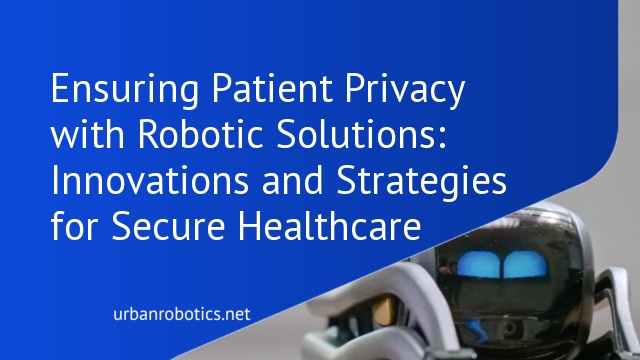Understanding Patient Privacy
Patient privacy involves the protection of personal health information (PHI). All healthcare providers must adhere to regulations like HIPAA to ensure confidentiality. Robotic solutions generate and handle vast amounts of PHI during medical procedures and patient care.
We need to examine how these robots process and store sensitive data. Encryption techniques and secure data storage methods are crucial to protect privacy. Robots often collect real-time data, making it vital to implement stringent access controls.
Data breaches occur when unauthorized entities gain access to PHI, risking patient trust and safety. It’s important to regularly update security protocols. For example, reinforcing firewalls and using multi-factor authentication can prevent such incidents.
Ensuring transparency about data handling practices fosters trust between healthcare providers and patients. We must communicate the measures taken to secure patient information. This includes detailing how robotic systems manage and protect PHI during their operations. By doing so, we can maintain patient confidence in robotic healthcare solutions.
The Role Of Robotics In Healthcare
Robotic solutions are driving transformative changes in healthcare. With multiple applications, these technologies enhance patient care while requiring stringent privacy measures.
Current Applications Of Robotic Solutions
Robots are now integral to surgeries, diagnostics, and patient management. Surgical robots assist in minimally invasive procedures, reducing recovery times and improving precision. Diagnostic robots analyze medical images faster and more accurately than traditional methods, aiding in early detection of diseases. In patient management, robots provide support in medication delivery and vital signs monitoring, ensuring consistent and timely care.
Advantages Of Robotics For Patient Care
Robotics significantly improve patient outcomes. Precision in surgical procedures minimizes human error, reducing complications. Consistent monitoring and timely interventions by robots enhance patient safety. Additionally, these technologies free up healthcare professionals to focus on more complex patient needs, optimizing resource allocation. Robots also help maintain patient privacy by securely handling data, adhering to regulations like HIPAA, thus building trust in tech-driven care.
Privacy Concerns With Robotic Solutions
Robotic solutions in healthcare raise several privacy issues. As technologies advance, we must address these concerns to maintain patient trust and ensure compliance with privacy regulations.
Data Collection And Storage
Robotic systems in healthcare collect extensive patient data. This data includes medical histories, imaging results, and real-time monitoring information. Proper storage practices are essential to protect this sensitive information. Using robust encryption methods, secure servers, and access protocols ensures data remains confidential. Without these measures, patient trust can erode, and privacy violations can occur.
Unauthorized Access Risks
Robotic healthcare solutions face significant unauthorized access risks. Hacking attempts, system vulnerabilities, and insider threats can expose patient data. Implementing multi-layered security strategies, including firewalls, anti-malware software, and strict access controls, is crucial. Regular system audits and updates help identify and address potential security gaps, protecting patient information from unauthorized access.
Strategies For Enhancing Privacy
Implementing effective strategies ensures patient privacy when utilizing robotic solutions.
Data Encryption And Security Protocols
Employ encryption to protect patient data. Use advanced encryption standards (AES) for secure data transmission and storage. Implement security protocols like Transport Layer Security (TLS) to shield data during transfers. Utilize encrypted databases to prevent unauthorized access. Conduct regular vulnerability assessments to identify potential weaknesses in encryption and protocol implementations.
Regular Audits And Compliance Checks
Perform regular audits to maintain compliance with privacy regulations. Schedule periodic checks to ensure systems adhere to Health Insurance Portability and Accountability Act (HIPAA) standards. Use automated tools to streamline compliance tracking. Ensure audit logs are stored securely and reviewed regularly. Address identified vulnerabilities promptly to maintain system integrity and patient trust.
Future Trends In Robotics And Patient Privacy
Future trends in robotics and patient privacy will shape the next era of healthcare innovation. These advancements aim to balance improving care quality and safeguarding sensitive patient information.
Innovations On The Horizon
Emerging technologies in robotic healthcare promise to revolutionize patient privacy. Advanced artificial intelligence (AI) algorithms ensure data anonymization during processing. Integration of blockchain technology offers decentralized data storage, reducing risks of breaches and unauthorized access. Wearable robotics provide real-time monitoring while strictly controlling data access. Predictive analytics in robotics can help preempt privacy threats by identifying patterns of potential breaches. For example, AI systems can alert healthcare providers of anomalies in data access in real-time.
Policy And Regulatory Developments
Regulatory frameworks must evolve to address innovations in robotic healthcare. The European Union’s General Data Protection Regulation (GDPR) sets strict guidelines for data privacy, influencing global policies. The U.S. Health Insurance Portability and Accountability Act (HIPAA) continues to adapt, incorporating provisions for robotic technologies. Ensuring compliance with these regulations is crucial for maintaining patient trust. Policymakers focus on creating standards for data encryption, periodic audits, and clear protocols for data breach responses. For instance, the integration of AI into HIPAA compliance tools streamlines the regulatory adherence process.
Conclusion
Patient privacy remains a cornerstone in the advancement of robotic solutions in healthcare. As we embrace these technological innovations, it’s crucial to implement robust privacy measures to protect patient data. By leveraging advanced encryption, security protocols, and compliance audits, we can safeguard sensitive information while benefiting from the precision and efficiency of robotic healthcare.
Looking forward, emerging technologies like AI-driven data anonymization and blockchain will play a significant role in enhancing privacy. It’s imperative for policy frameworks to evolve alongside these innovations to ensure patient trust and data security. As we navigate this exciting intersection of technology and healthcare, our commitment to patient privacy will be paramount.





